People use sketchbook diary prompts like “Your Favorite Word Illustrated” or “A Song That Moves You” to turn feelings into art. Drawing a special cup of tea, a memory from childhood, or even a dream travel spot makes thoughts come alive on the page. From doodling gratitude or sketching crazy animal shapes, to spotting weird sidewalk patterns, these prompts get creative juices flowing. Self-portraits with a wild twist keep things unpredictable—stick around, there’s plenty more inspiration coming your way!
Key Takeaways
- Illustrate your favorite word using expressive lettering and doodles to explore its personal meaning.
- Capture a memorable childhood experience through sensory details and sketches that evoke nostalgia.
- Visualize three things you’re grateful for with simple drawings to reinforce positivity and reflection.
- Depict a dream travel destination using colors, landmarks, and quick sketches to convey excitement.
- Draw everyday objects from new perspectives, adding patterns or textures to reveal overlooked details.
Your Favorite Word Illustrated
Words can be a lot more powerful than people think, especially when one of them seems to jump right out and stick with you.
In your journal or Art Journal, picking a favorite word is like finding a secret treasure you didn’t know you had. Boldly draw it in big, wild fonts—try bubble letters or even fancy script.
Play around with the size, make some letters super tiny, others huge. Grab your favorite art supplies—colored pencils, watercolors, gel pens—and go wild with color.
Doodle stars, vines, or silly faces around the word to reflect how it makes you feel. As you work, think about why this word matters to you.
Let those thoughts inspire every line, splash, and squiggle on your page.
A Song That Moves You

When a song really hits home, it has a way of painting pictures in your mind, kind of like a soundtrack for your own story.
By sketching out the lyrics or using colors and shapes to capture the mood, anyone can show exactly how the music makes them feel—happy, angry, totally unstoppable, or maybe even a little teary.
Turning a favorite tune into a visual journal page is like making your own album cover, only way more personal and way less pressure from record labels.
Visualizing Song Lyrics
Ever wondered what your favorite song might look like if you could actually see its emotions and stories?
Visualizing song lyrics is an art journaling prompt that challenges you to turn music into pictures. With art as your tool, pick a song that stirs something in your heart.
Next, listen to the lyrics carefully—what moods and images pop into your mind? Use watercolors for dreamy vibes, bold acrylics for energy, or even digital art if you love using tech.
Mix in the actual words with hand-lettered lyrics for extra flair. Doodle around the text to highlight the song’s theme.
This journal prompt doesn’t just capture sound; it captures how the music makes you feel—perfect for those who’ve always wanted to draw what they hear.
Expressing Emotions Through Art
How does a song sneak into someone’s heart and set off an emotional explosion? Imagine listening to your favorite track—suddenly, waves of feeling rush in, making your sketchbook diary feel way more alive than a simple written journal.
Expressing emotions through art is supercharged when you pick a song that really moves you. Drawing, painting, or even doodling around song lyrics opens up a world where colors and shapes become your voice.
Acrylic paints can turn backgrounds into glowing vibes, making those lyrics (and your feels) pop even better! Mixing creative lettering or technical skills, like outlining or shading, gives your pages some serious personality.
Ultimately, creating a lyrics-themed art journal helps people dig deep into what a song truly means to them—no music degree required!
Today’s Cup of Coffee or Tea
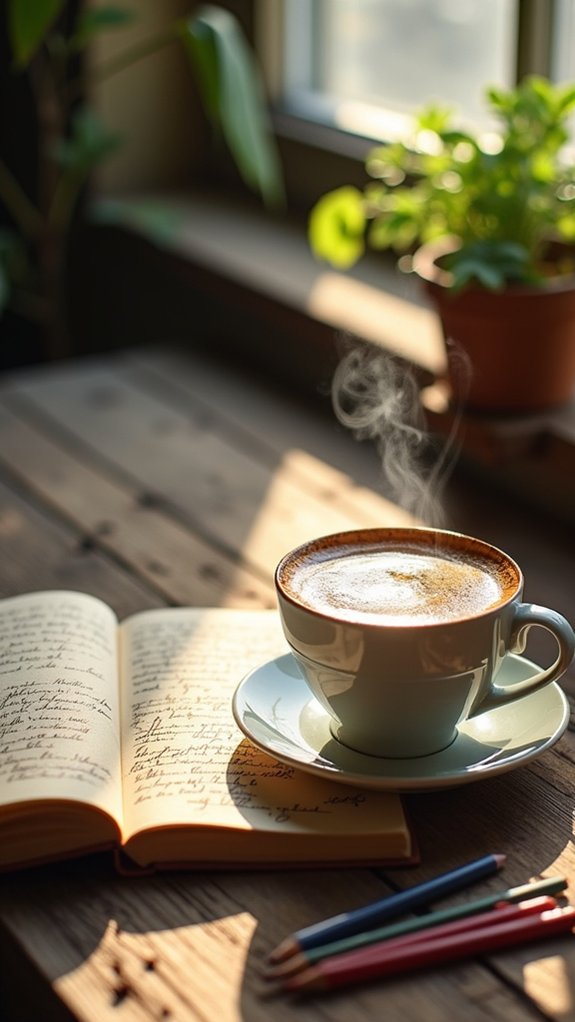
A single cup of coffee or tea can turn an ordinary moment into something pretty special.
The whole point of this sketchbook prompt is to slow down, notice details, and draw from all five senses. Is your tea steaming with a fruity aroma? Maybe your coffee is bold, warm, and cozy in your favorite chipped mug!
Think about where you’re sipping—maybe it’s a cluttered desk, a sunny kitchen, or a picnic blanket. Capture light or shadow, crumbs or cookies, plus the way you feel right now.
Here are four ways to make your page pop:
- Sketch the cup with different styles—realistic, cartoonish, or abstract.
- Use watercolors to show warmth and richness.
- Collage labels or quotes.
- Write a quick, honest reflection.
An Everyday Object in a New Light
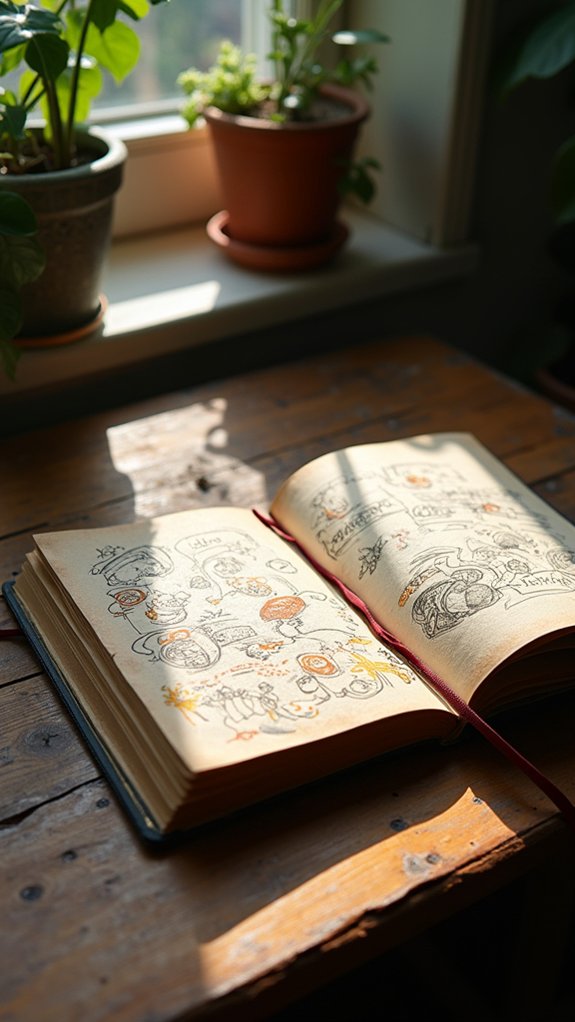
Why does a boring old pencil suddenly seem so interesting when it’s rolling off the edge of a cluttered desk?
Maybe it’s because, with a little object significance exploration, even the most everyday things can surprise us.
Sketching that pencil—or a coffee cup, or glasses—from different angles is a unique perspective drawing challenge. Are there scratches, fingerprints, details you’ve never noticed?
Now add some wild patterns or quirky textures; maybe those glasses need zebra stripes! Choose emotional color choices, like neon pink for energy or deep blue for calm, connecting your feelings to the object.
Write a quick reflection about why this object matters in your day.
Want more excitement? Imagine your pencil in outer space or a giant’s pocket. Suddenly, it’s extraordinary.
A Memory From Childhood
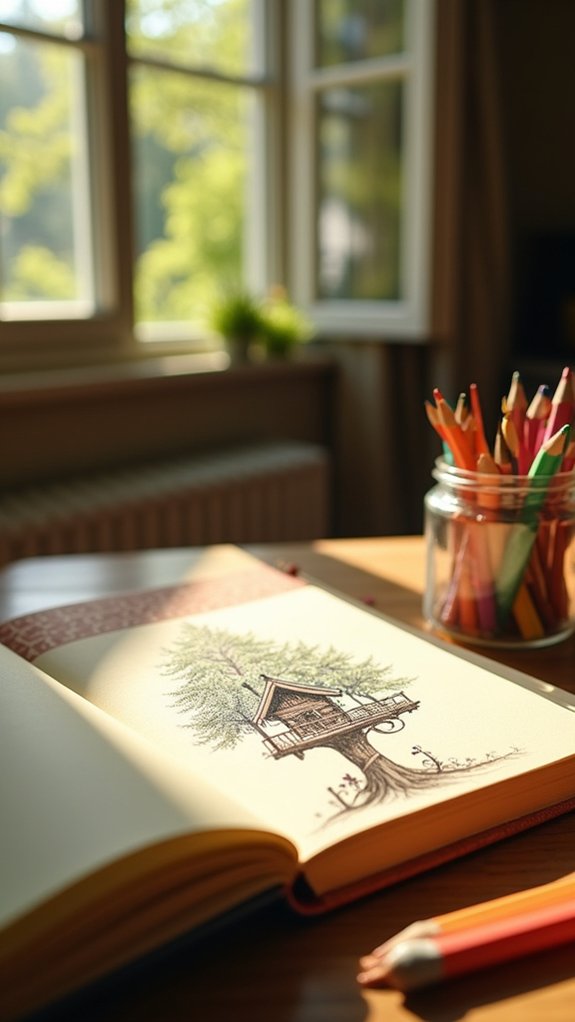
Ever notice how just thinking about an old childhood memory can send a wave of feelings crashing in?
Childhood nostalgia almost has a superpower—it can instantly transport someone back to the days when the world felt huge and every discovery was a new adventure.
Capturing a childhood memory in a sketchbook isn’t just fun; it’s a brilliant way to reveal sensory details, like the chirp of backyard crickets or the sweet smell of summer grass.
It also lets artists see how much personal growth has happened since then.
Want to make that memory come alive?
- Name your age and list who was there—characters add flavor.
- Jot down any sounds, smells, or tastes.
- Show the location in your drawing.
- Reflect on how you’ve changed since then!
The View Outside Your Window
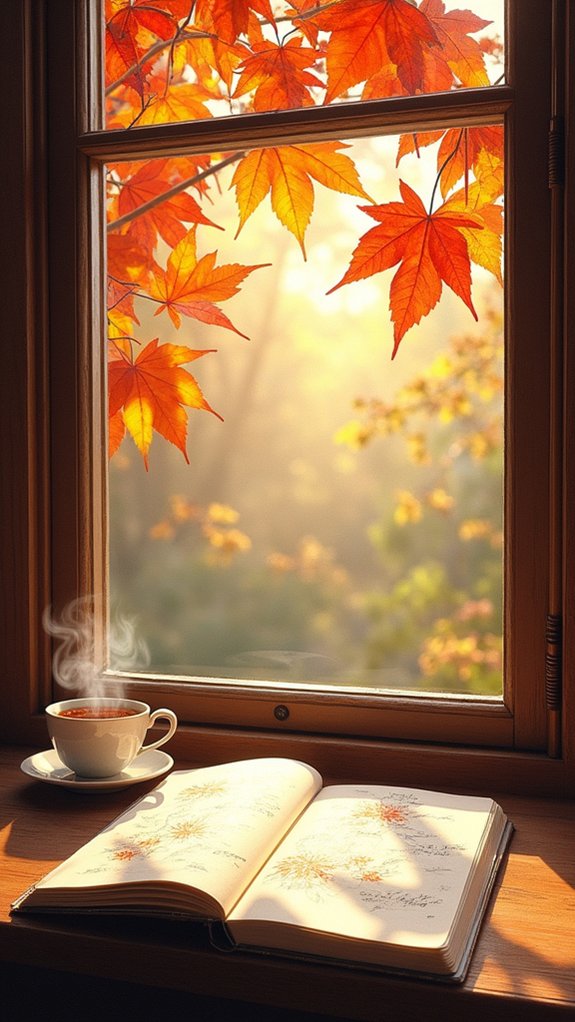
How often does someone actually stop to notice the little world right outside their window? The view from a window is like a living, breathing postcard, changing with every hour and season. Sketching this scene not only sharpens observational skills but also gives a chance to play with window reflections, or try out new textures in seasonal sketches. Capturing falling leaves, distant rooftops, or a sneaky cat prowling by encourages perspective practice and helps artists see things differently. Whether using ink or colored pencils, documenting the outside view brings out details you might have missed. Plus, it’s easy to start and always changing, making it the perfect prompt for any sketchbook diary. Here are some window prompt ideas:
| Time of Day | Weather | Focus Point |
|---|---|---|
| Morning | Rainy | Tree branches |
| Afternoon | Sunny | Window reflections |
| Evening | Snowy | Distant buildings |
| Night | Foggy | Streetlights |
Your Mood as a Doodle
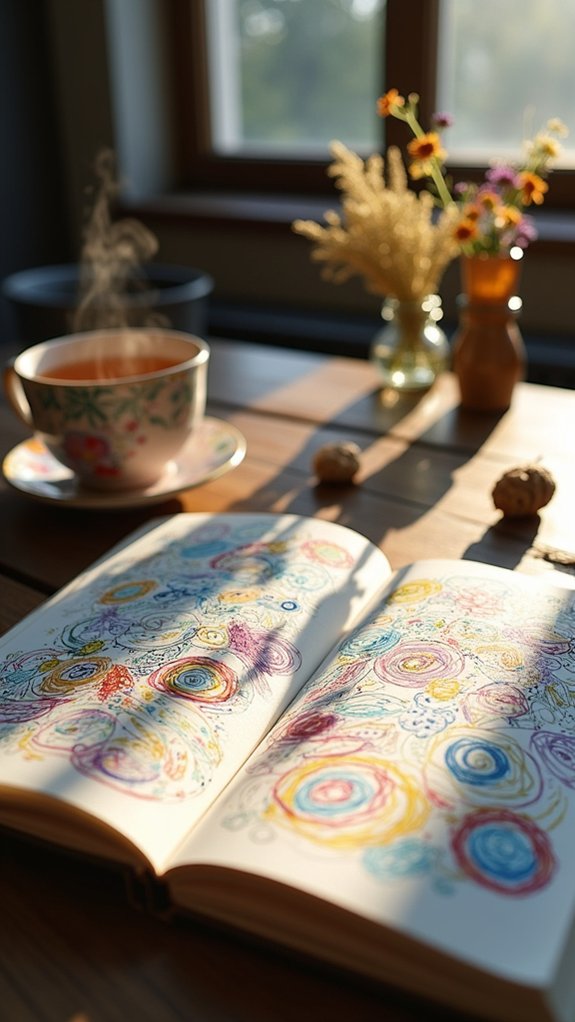
Sometimes, it feels like emotions have a mind of their own—one minute, everything’s chill, and the next, a storm of feelings shows up out of nowhere. That’s where doodling comes in! By grabbing a sketchbook, anyone can convert their current mood—whether it’s a thundercloud or a sunny day—into shapes, squiggles, and colors.
Paying attention to Mood Patterns helps people notice if they’re spinning the same design every time things get intense. Mixing up Color Choices can be huge; red lightning bolts for frustration or blue waves for a mellow vibe. Trying different Doodle Techniques, like thick, bold lines, or soft, swirling shapes, helps each mood stand out.
- Spot your Mood Patterns
- Experiment with Color Choices
- Explore Doodle Techniques
- Create a mood tracker through art
Three Things You’re Grateful For

When life gets stressful or weird, taking a few minutes to think about three things you’re grateful for can feel like flipping on the lights in a dark room—suddenly, the good stuff pops into view.
This simple daily appreciation practice isn’t just warm and fuzzy; it actually helps your brain develop positive mindset techniques. Scientists say that jotting down what you’re thankful for can lower stress, boost your mood, and even help with anxiety.
A sketchbook is the perfect spot for gratitude visualization. Doodling your favorite snack, friends, or that one super comfy sweatshirt turns appreciation into art. Plus, looking back through your pages is like a little highlight reel for tough days.
Noticing small joys can make even the weirdest days brighter.
A Place You Want to Visit

Thinking about a place you really want to visit can make your sketchbook pages practically buzz with excitement, like you’re already halfway there in your mind.
Visualizing your dream destination—imagining the colors, the streets, the food, even what the air might smell like—can help you sketch and write about all the things you hope to see and do.
It’s totally normal to feel nervous or super hyped about your trip, so why not let those pre-trip emotions splash onto the page right alongside your drawings?
Visualizing Your Dream Destination
Ever wonder what it would feel like to step into the place you’ve always dreamed of visiting?
Visualizing your dream destination in a sketchbook isn’t magic, but it comes pretty close. It mixes your wildest travel inspiration with artistic interpretation, helping you imagine the sights, sounds, and even the smells of somewhere you’ve never been.
Some people choose to do quick sketches, splash on colors that remind them of the setting, or add quirky notes about what drew them there in the first place.
Want to make your own entry? Try these steps:
- Sketch the scenery and main attractions of your dream destination.
- Add color swatches to capture the vibe or mood.
- Include little maps or travel symbols.
- Jot down reasons why this place excites you!
Capturing Pre-Trip Emotions
How does it actually feel right before going somewhere you’ve always wanted to visit? It’s like having butterflies in your stomach made of pure pre trip excitement. There’s emotional anticipation building with every travel video you watch and every map you sketch into your journal. Writing down travel aspirations and dreams—the foods you want to try, the places you hope to snap a selfie—makes the wait even more electric. Sometimes there’s a splash of nerves too, wondering what unexpected things might pop up. Try using a prompt, like “What excites me most about this trip?” or “What am I worried about?” to organize your feelings before you go.
| Feeling | Example Thought |
|---|---|
| Excitement | “I can’t wait to see the Eiffel Tower!” |
| Nervousness | “What if I get lost?” |
| Curiosity | “Will the locals like visitors?” |
| Hopeful | “Maybe I’ll make a new friend!” |
| Overwhelmed | “There’s so much to plan!” |
Patterns Found Around You
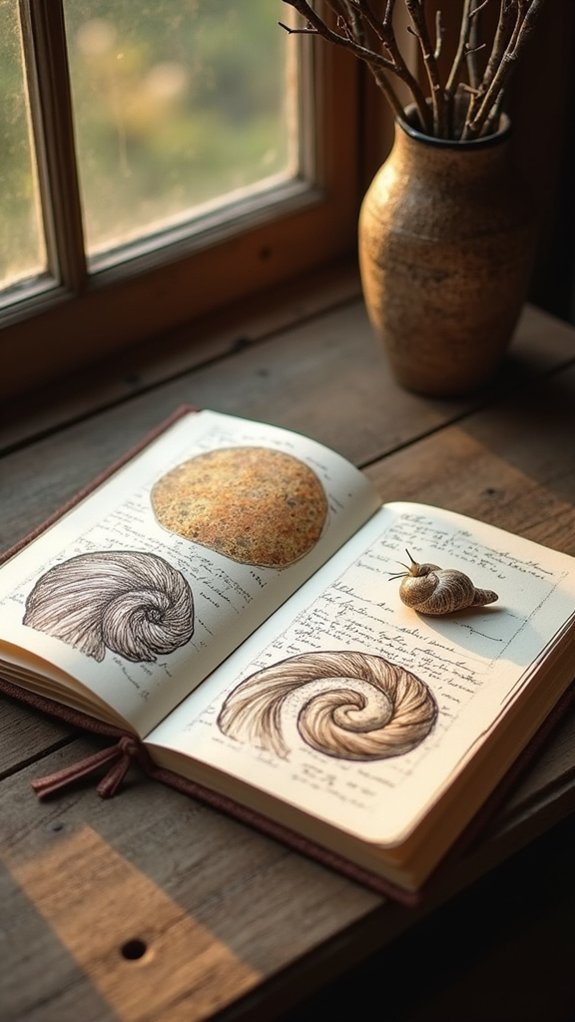
Patterns are everywhere, just waiting to jump out at anyone who takes a moment to really look around. From the zig-zag tiles at school to the dizzy spirals in tree bark, patterns shape the world in fun and unexpected ways.
Pattern exploration techniques can turn an ordinary sketchbook into a vibrant diary. Nature pattern sketches let you play detective, hunting down cool leafy or rocky designs. Sometimes you’ll even spot fabric design inspiration on your own clothes! Sketching patterns isn’t just fun, it also boosts your observation skills.
Here are some ways to start:
- Try drawing pattern repeats from a favorite T-shirt.
- Sketch the way sunlight makes shapes on your bedroom wall.
- Explore sidewalk cracks as wild, random designs.
- Create new motifs based on nature’s patterns.
An Animal That Inspires You
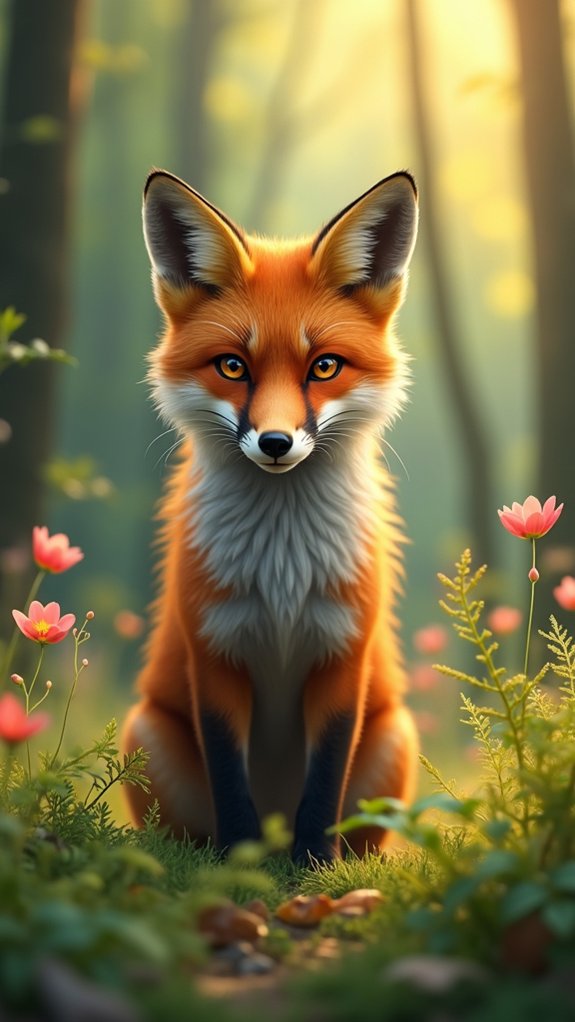
Choosing an animal that inspires you can mean way more than just drawing a cute creature—it’s about finding something that matches your energy or dreams, whether that’s the clever fox or the unstoppable turtle.
When sketching, pay attention to how that animal moves and the cool patterns or textures in its fur, feathers, or scales—seriously, it can make your page come alive.
There’s real power in picking up your pencil and trying to capture not just how an animal looks, but what it means to you, even if it’s just your goldfish who always looks optimistic at dinnertime.
Symbolism and Personal Meaning
Even though it might sound a bit wild, sketching an animal that inspires you is like putting a piece of your own spirit onto the page. It’s a perfect way to dig into animal symbolism exploration and think about what certain animals mean to you, or even across different cultures.
For example, are you team owl for wisdom, or cheering for the brave lion? There’s also personal connection significance—maybe a fox reminds you of someone special or a memory that still makes you smile.
Plus, the colors and patterns you choose turn your drawing into a mini story about where that animal lives or what it stands for. Consider these prompt ideas:
- Pick an animal and research its symbolism.
- Write about your personal connection.
- Explore cultural meanings.
- Illustrate with meaningful colors.
Capturing Animal Movement
Get ready to bring your animal sketches to life—no magic wand required, just some sharp observation and a little practice!
Watching animals move, whether it’s a squirrel zipping up a tree or a cat stretching lazily, lets artists pick up on all the cool details of balance and motion. Gesture drawing techniques—quick, loose sketches—are perfect for capturing those moments before they’re gone.
Instead of sweating every tiny detail, focus on observing animal anatomy, like how muscles and joints work together. Try using videos or even a trip to the park as reference.
Changing angles and perspectives? Yes, please! It keeps your sketchbook lively. Practicing this way not only sharpens skills, but also totally enhances artistic expression, making animals leap right off the page!
Exploring Texture and Pattern
After nailing the wild energy of animal movement, it’s time for a whole new challenge—texture and pattern!
Staring closely at an animal, you’ll notice their fur, feathers, or scales are basically nature’s fashion statements. But there’s more than meets the eye! Immerse yourself in texture exploration techniques and see how animal pattern significance can bring a sketch to life.
Don’t be shy—experiment using creative sketching methods, too. Here’s what you can try:
- Study a critter’s unique surface, from soft paws to scales, and sketch what stands out.
- Use stippling or hatching to show fluff, fuzz, or even shiny fish scales.
- Add background patterns—think zebra stripes or leafy camouflage.
- Try charcoal, watercolor, or pastels for new textures.
Self-Portrait With a Twist

Why stick to the usual when drawing a self-portrait can be a wild adventure? A self-portrait with a twist is all about identity exploration—it lets artists move beyond the “mirror image” and get creative. Instead of just drawing their face, they might add skateboard wheels for hair, or doodle dreams floating above their head! With artistic techniques like collage, mixed media, or bold colors, anyone can create a version of themselves where personal symbolism really pops. Imagine a portrait where your favorite animal holds your heart, or your hobbies whirl in the background like fireworks. Here’s what these wild self-portraits might include:
| Artistic Element | Symbolic Idea |
|---|---|
| Colorful Swirls | Emotions and moods |
| Doodles | Hobbies and interests |
| Collaged Photos | Special memories |
| Abstract Shapes | Personality traits |
| Iconic Objects | Life dreams or goals |
Frequently Asked Questions
What Are Some Good Prompts for Journaling?
When considering good prompts for journaling, one might suggest questions that encourage daily reflections, explore personal goals, or invite creative expression through visual storytelling—such as noting inspirations, practicing gratitude, or capturing the impact of surroundings on mood.
Can You Use a Sketchbook as a Diary?
A sketchbook can function as a diary, enabling artistic expression and visual storytelling alongside written entries. Through creative reflection, individuals can document thoughts and experiences, combining art and words for a richer, more personal record of life.
How to Start a Sketchbook Diary?
To start a sketchbook diary, one chooses a versatile sketchbook, establishes a routine for daily reflections, and selects materials for creative expression. They explore visual storytelling by capturing thoughts, experiences, and emotions through drawings, mixed media, and written annotations.
What Are Journal Prompts for Mental Health?
Journal prompts for mental health offer mindfulness exercises, encourage emotional expression, and promote self reflection techniques. These prompts help individuals process feelings, track mood patterns, and cultivate gratitude, supporting ongoing mental well-being and healthier coping mechanisms over time.
Conclusion
Sketchbook diaries are kind of like time machines—they catch wild ideas, zig-zagging thoughts, and bursts of creativity all on one page. With these twelve prompts, anyone can fill their book with real memories, goofy doodles, and surprising bits of themselves. So, if your pencil is tapping and your brain is buzzing, just flip open your sketchbook. Who knows what you’ll discover the next time you start drawing? One thing’s for sure: it’ll be totally you.

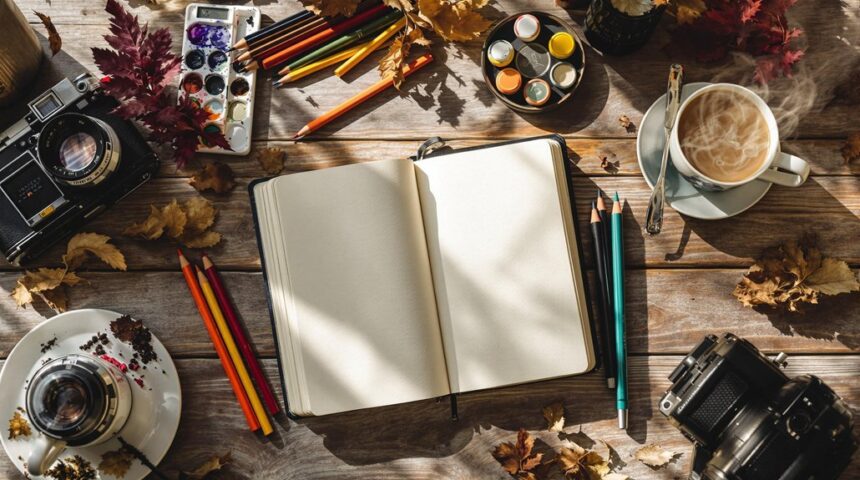
Leave a Reply